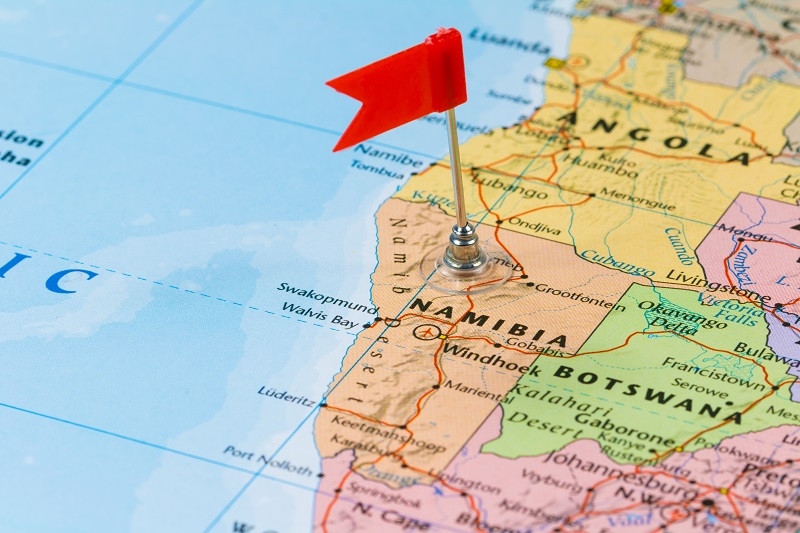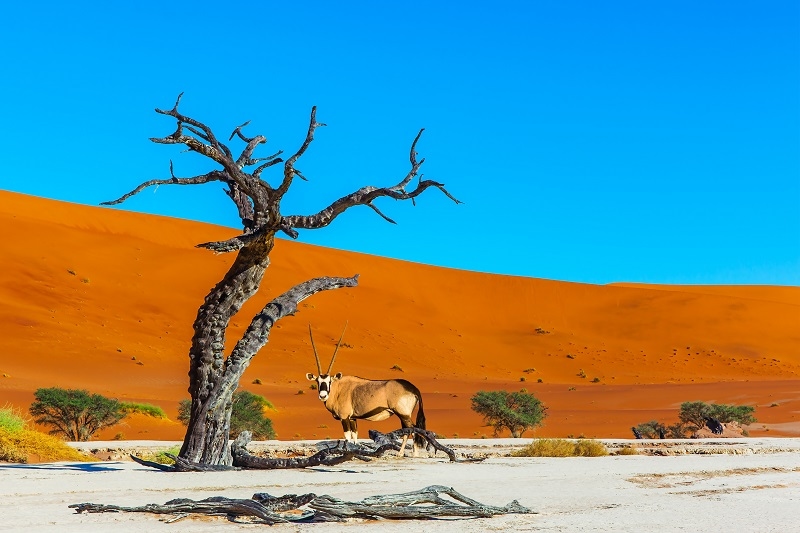
If you're looking for a place with unspoiled, raw beauty and endless adventure, Namibia is the jewel of Southwest Africa and one you should prioritize on your list. Visiting the amazing country isn't only a vacation—it's an adventure that will bind you to nature, culture, and the power of the land.
In this comprehensive travel guide to Namibia, we will discover its surreal desert scenery, teeming wildlife, and mythical road trip adventure destinations. Whether you wish for a desert safari Africa, hiking the fabled Sossusvlei dunes, or tracking big cats in wildlife parks Namibia, this guide is your ideal holiday guide.
Namibia offers an unparalleled combination of alien landscape and genuine diversity. It's located in the west of Africa, and it's one of the least densely populated countries on the planet, so visitors are greeted by a nearly suffocating sense of space. Breathtaking sand dunes, salt pans which split like old prawns, ancient rock art, and game that thrives in the desert all combine to give Namibia a land of contrasts and enchantment.
This travel guide to Namibia is perfect for nature lovers, adventure seekers, photographers, and anyone who wants a destination where the sea meets the desert and lions nap on the dunes.
Let us start with one of the world's oldest deserts—the Namib. This apparently endless sea of rust-red dunes of sand and open emptiness hugs the Atlantic shore and shapes Namibia's extraordinary topography. An African desert safari does not get more legendary than this.
The Namib Desert isn't a setting; it's a player in your experience. On a desert safari with a guide, you may see oryx bounding across dunes, follow elusive desert elephants, and even catch a glimpse of the shy brown hyena. The desert is painted with color at dawn and dusk, giving photographers and nature lovers enchanting photography opportunities.
No Namibia guide would be complete without a reference to the Sossusvlei dunes—arguably the world's most photographed dunes. Sossusvlei, in the Namib-Naukluft National Park, features enormous star-shaped dunes that are 300 meters high. The colored dunes, which become more vibrant with time and change from burned orange to glorious red and deep purple in altered conditions, stretch out for miles.
Climbing "Big Daddy," one of the tallest dunes, is physically grueling as well as an emotional test. The view from the top is one of Deadvlei, a ghostly white clay pan dotted with centuries-old dead camelthorn trees, sculptures in a sea of sand. This place sums up the essence of African desert safari: hot, stunning, and unforgettable.
Namibia has some of the best wildlife reserves in Africa, and most of them are easily available for self-drive and first-timers as well. The jewel of Namibia's parks is Etosha National Park in the north. Its massive salt pan and surrounding veld are home to elephant, lion, leopard, black rhinoceros, zebra, and over 300 bird species.
The park is unique in that it has numerous waterholes, so it's a paradise for a photographer when there's drought and the animals mass in very huge numbers. You can stay there for days without completely requiring a guide, thanks to its excellent road surfaces and exceedingly good signposted vantage points.
Other off-the-beaten-track but no less stunning parks are:
Skeleton Coast National Park – A rocky shoreline scattered with wrecks of ships and lions and brown hyenas acclimated to the desert.
Nkasa Rupara National Park – A wetland heaven near the Zambezi Region, ideal for birdlife and adventure enthusiasts in search of off-the-beaten-path activities.
No travel guidebook to Namibia will be complete without Namibia's commitment to environmental protection and community-led wildlife tourism, enabling wild animals and human beings to live in harmony.
Namibia is the ideal destination for overlanding. With its smooth gravel roads, stunning scenery, and light traffic, it is one of only a few countries on the African continent where overlanding on your own is not only possible but truly advisable. Overlanding Namibia affords you the freedom to pull over when and where you choose, take in the views, and even feel the rhythm of the country.
Whether down the Skeleton Coast along the Atlantic shoreline, along Swakopmund's foggy dunes, or way out into Damaraland in search of early rock engravings, every section of road is one of story.
Top road trip itineraries include:
Windhoek to Etosha – A classic first encounter with Namibia's wildlife reserves.
Swakopmund to Sossusvlei – Sea breeze mixed with the heart of the Namib Desert.
The Caprivi Strip – A less traveled route across verdant, river-supplied northeast so distinct from dry south.
Getting around Namibia is planning. Always carry spare fuel, water, and a spare tire—and enjoy the relaxed, unhurried tempo that car travel in Namibia fosters.

Tourism in Southwest Africa is not so much about scenery--it's also a chance to taste indigenous culture. Namibia boasts a diverse group of ethnic groups like the Himba, Herero, San (Bushmen), and Damara, each of whom possess a special language, different dressing, and different way of life.
There are numerous Namibian community-owned lodges and cultural tours that are respectful and strive to generate income while conserving heritage. If a responsible tourist engages in these, there is a call for sensitivity—ask questions, appreciate, and always use ethical tour operators. A good travel guide to Namibia calls for venturing beneath the surface, as in more meaningful culture immersion.
If dune climbing and wildlife watching are not enough, Namibia has plenty more for the thrill-seeker. Some of the activities that have to be done are:
These journeys bring a new perspective on the experience of Southwest Africa travel, that Namibia is just as contemplative as it is zesty.
Namibia is a year-round destination, but the best time depends on your taste.
Dry season (May to October) – Best for game viewing and driving in Namibia.
Green season (November to April) – Fewer dust, more birds, and fewer tourists, but some roads will be harder to navigate.
It is cold at night in the desert and scorching during the day, so dress warmly and stay very well-hydrated.
No travel guide to Namibia would be worth its salt without mention of the enriching cultural encounters to be experienced beyond its deserts and game reserves. While the breathtaking sand dunes of Sossusvlei and spine-tingling desert safari Africa tours tend to steal the spotlight, the heart of Namibia is located in its out-of-the-way villages, where age-old traditions and community values reign supreme.
This gives them invaluable insights into how human beings have adapted in terms of surviving in dry environments, generating livelihood based on the cleverness of their ancestors, and preserved languages, conventional skills, and customs in the face of modern way of life.
These also entail participation in visits to cultural villages or homestays, where mutual interaction is encouraged.
Whether it's the rust-hued sand dunes of Sossusvlei, the peaceful quiet of the Namib, or the thundering hooves across the grasslands of Etosha, Namibia has a tendency to stay in your mind long after you've pulled out the camera and headed on home. It's unrestricted, it's open, and it's tremendously humbling.
This Namibia guidebook is only a starting point. The wonder is really in the doing—driving down an apparently endless road, under star-filled skies at night, or just sitting there as a giraffe sips from a waterhole a few meters away. So bring some awe with you, your astonishment, and your enthusiasm for unspoiled nature. To drive Namibia's deserts and game parks is not just another vacation—it's an epiphany. Let the spirit of Southwest Africa inspire your next big adventure.
This content was created by AI